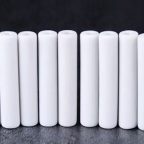Structural ceramic materials are divided into two categories: structural materials and functional materials. When a material mainly uses its mechanical properties, this material is called a structural material. If it mainly uses its non-mechanical properties, it is called a functional material. In the literature, functional materials are often defined as “materials that utilize their physical properties”. From the perspective of discipline classification, physical properties are relative to chemical properties, mechanical properties are included in physical properties, and functional materials include chemical functional materials. Appropriately, mechanical properties usually refer to strength, plasticity, toughness, elasticity, hardness, fatigue, etc.; non-mechanical properties mainly refer to sound, electricity, time, magnetism, and chemistry.
Structural Ceramics
For some specific materials, it is sometimes quite difficult to strictly classify them into which category, such as bearing materials, in addition to requiring strength, there are also problems of lubrication and wear reduction; installation porcelain, in addition to requiring good insulation, It must be strong enough.
The structural application of ceramics is one of the earliest applications of ceramics, but the development of advanced structural ceramics is relatively late, starting in the 1960s and 1970s. In order to meet the material needs of the rapidly developing aerospace, aviation, atomic energy and other technologies, especially for high temperature materials, people turn their attention to ceramics. The heat-resistant temperature of metal high-temperature materials has developed from about 800 degrees in the 1940s to about 1100 degrees in the 1970s. It is becoming more and more difficult, because limited by the melting point of the metal matrix, the increase in the heat engine temperature not only means a reduction in fuel consumption , and it means an increase in output power.
Pintejin machining ceramic service include : Alumina Ceramic Parts, Zirconia Ceramic, Silicon Carbide Ceramic, CNC Machined Aluminum Nitride Ceramic, Machinable Ceramic Parts, Glass Ceramic,Macor Ceramic,Powder Metallurgy Dies,Ceramic Injection Molding,Ceramic Dry Pressing,Ceramic Extrusion Dies




